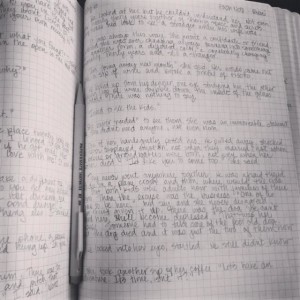Yes, my main mode of writing a novel (or anything else) is via computer. It’s easy, and since I can type approximately 70 words per minute, if I get on a nice little writing jag, I can pump out paragraphs in no time at all. Everything is online these days…everything, including writing. If you’re a writer who doesn’t have a computer (horrors!) or Internet access (blasphemy!), you are an old-school dinosaur writing at an insurmountable disadvantage.
So yes, my laptop is my bestie, and thanks to the World Wide Web, people on every inch of the globe can read not only my words, but everyone’s words, if they so desire. Instant knowledge at the tips of your fingers, what’s more Nirvana than that? However… since my work involves heavy computer usage, my eyes get tired. I personally despise looking at computer monitors, especially after 8 or so hours of squinting into one at work. While the Kindle is nice, I find it difficult to read any words on a screen, much less my own. I haven’t mastered Scrivener, so I use Word which is the worst word processing program ever! It’s cumbersome, it’s hard to format (if you want to go beyond the standard 1″ margins all around), it’s basic, the dictionary and thesaurus suck, and well…I’m sometimes too tired by the time I get around to creating words on a page to fuss with it. I consider Word a necessary evil.
Call me old-fashioned, but I still write in notebooks. With a number 2 pencil – a Papermate Sharpwriter. (Excellent lead, sturdy eraser.)
First of all, there’s the notebook fetish. I love, love, love notebooks. My favorite for writing is the larger Moleskine with graphing lines, like the one pictured above. The lines keep my handwriting on track, plus, those squares are handy for plotting out scenes, easy to divide into columns, rectangles, or other shapes. I’m a pantser, so I don’t outline, but I can set scenes into this notebook. I need visuals and highlights and graphs. I might draw a scene, although my artistic skills are nothing to brag about. After I’ve got the basics down, I go back to the computer and type them into my Word document.
Each notebook contains all of the information I need for each novel. (I tried combining different stories in the same book; it just doesn’t work. Too confusing.)
I have notebooks of every size and color for other things. A small one always at the ready in my purse. Sometimes I’ll hear or see something, and jot it down so I won’t forget. (Because if I didn’t, I’d surely forget. I’m old, remember?)
I’m hoarding notebooks and pencils for the Apocalypse. Okay, so maybe when the earth is scorched and radioactive, I won’t have hands to write my stories. Still, it makes for a good excuse.
And yes, I am old school. I began writing before computers. I submitted my first story (typewritten) to a contest when I was 16, but before getting down to the typing (back then I was a terrible typist and my Remington didn’t have an erase mode), I worked my manuscript on paper many times before I committed to the final draft.
There is something about handwriting your work that makes it precious, especially when doing writing prompts. You might think the well has run dry, but give yourself twenty minutes to fill a page with your own handwriting, and it will be done. Staring at a computer screen promotes procrastination, at least, for me. I need the manual labor of writing to get me going. It’s also nice to see a notebook full, every page taken up with words and whimsy. You can see it, it’s tangible, you can feel it, not like you can when you open up folders on a hard drive.
So if you’re experiencing a slump, a blockage, or just want to try something different, consider handwriting in a notebook.








